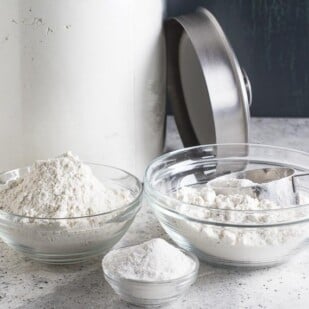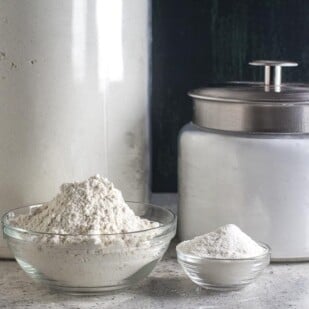This Caputo Fioreglut Gluten-Free Low FODMAP Pizza is just one of many gluten-free pizza recipes that we have for you. This one features Caputo Fioreglut Gluten-Free Flour, which contains an interesting ingredient: gluten-free wheat starch. Gluten-free wheat starch is made by washing away the gluten (it is literally a wet process), resulting in a very dry powdery starch. Fructans in wheat, being water soluble, are also removed and/or reduced. If you are in Elimination and treading conservatively, this might not be the recipe for you, but we have others. Try our Easy Low FODMAP Pizza, for instance. Know your own tolerances. And, please review our articles, Everything You Need To Know About Low FODMAP Pizza and also Low FODMAP Pizza Equipment & Ingredients before starting.
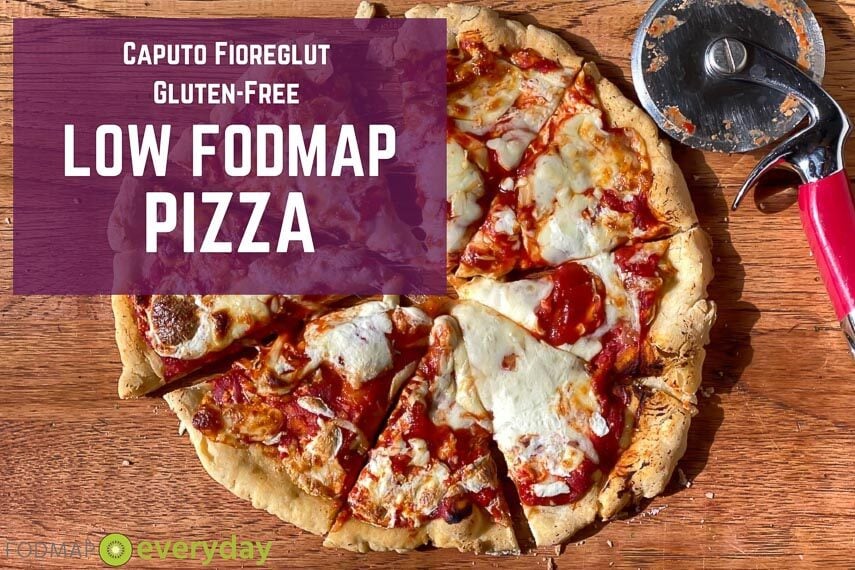
About Caputo Fioreglut Gluten-Free Flour
The reason I developed a pizza using this flour is because if you do any amount of gluten-free pizza research, this flour comes up again and again, so I had to take it for spin. Please note that the manufacturers changed the blend of ingredients at some point and some older bags might still be found on the Internet.
These are the current ingredients and the Caputo Fioreglut version I used: Gluten Free Wheat Starch, Dextrose, Corn Starch, Buckwheat Flour, Rice Starch, Vegetable Fibers, Guar, Flavorings.
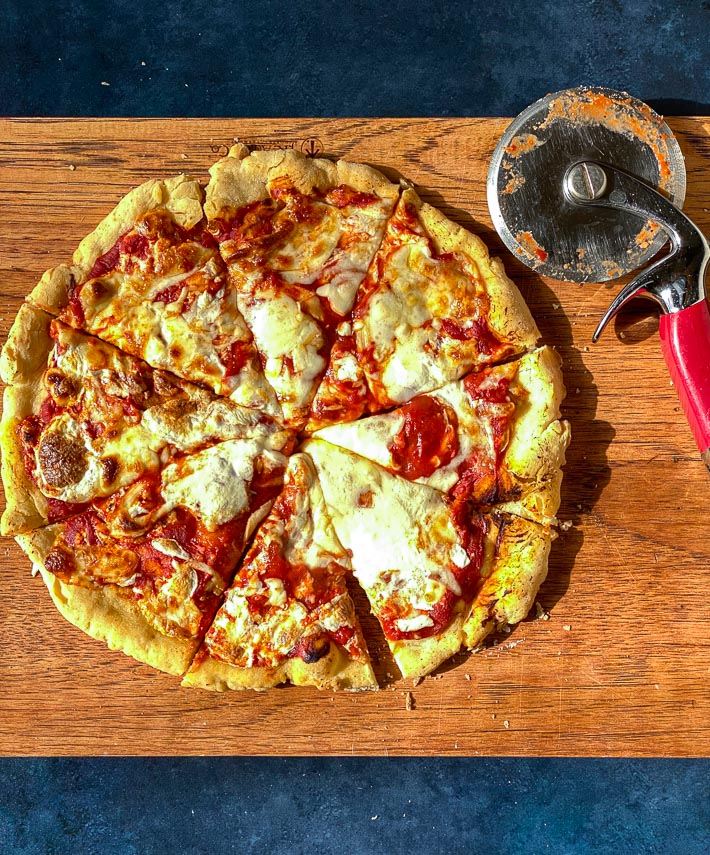
I contacted the manufacturer to ask about the fibers and the flavorings, specifically if the flavors were garlic and/or onion derived. Here is their response:
“The fibers are from psyllium seeds and the flavoring is a natural one. We cannot reveal the derivates because of internal policy.”
So, we do not know the answer re: flavorings, but at least it is the last ingredient.
Please review our article on How To Decipher Flavors & Spices On Labels (for info covering the US, AU and Canada).

We asked Monash researchers to comment on gluten-free wheat starch and they said they were not familiar with the product. FODMAP Friendly, however, has lab tested a similar product.
Similar Lab Tested Certified Low FODMAP Products
FODMAP Friendly has lab tested and certified LOFO Pantry All-Purpose flour and the ingredients are “Wheat starch, Vital wheat gluten and Guar gum”. According to this company, their “low FODMAP flour is made by removing FODMAPs through an all-natural, chemical-free wet extraction process”.
Presumably the FODMAPs in wheat – fructans – which are water soluble, are removed or greatly lessened with this wet process.
We don’t want to confuse anyone, so please read this entire section carefully.
The Caputo Fioreglut is gluten-free. The LOFO Pantry flour is not, but they have the processed wheat starch in common. The Caputo product has had some sort of additional processing to remove gluten.
I bring this to your attention to encourage you to read labels and learn as much as you can about the products and ingredients out there that might be of interest to you while following the low FODMAP diet.
Remember, the low FODMAP diet is not a wheat-free nor a gluten-free diet. It is also lower in FODMAPs, not no FODMAP.
This recipe will work best if the flour is weighed with a digital scale. This particular flour is incredibly light and powdery and hard to measure accurately by volume. I have offered you both volume and weights; I highly recommend you use the weights.
Caputo makes several flours, each with specific usage recommendation. The company actually suggests that pizza dough made with this Caputo Fioreglut Gluten-Free Flour be baked at 698°F (370°C). Our home ovens do not crank that high. The use of a Baking Steel helps immeasurable (more below), and I found that adding sugar helps with some browning. The finished pizza will still be a tad pale, compared to others of ours, and others that you are familiar with.
Yes! Instructions are below in the recipe, along with directions for using a stand mixer.
The 24-hour wait period gives you the best texture, flavor and workability. You can just let the dough rise for an hour in a warm, draft-free location and proceed as directed – you will get a pizza out of it – but try the 24-hour wait. It will be the best it can be.
I do not ask you to buy things unnecessarily. Here’s the deal – this recipe works beautifully if you make it as written. If you make any changes to ingredients or equipment, your pizza will suffer. I consider the baking steel to be part of this recipe, just like ingredients and oven temperature.
If you have a pizza stone, you can try it. Make sure to preheat in the oven for a full hour before launching your pizza – but the resulting pizza will still not be as great as when made with a Baking Steel – and that has to be preheated for a full hour as well. Yes, A FULL HOUR.
This dough is very moist and par-baking briefly on the parchment allows you to easily get it off the peel and into the oven, but you don’t want to leave it on for the full baking time, because you do want the dough to have some full contact with the hot steel.
You will be patting out your pizza disc on a parchment paper round (or square), cut generously so that it will be a little larger than your pizza, so that there are edges to grab. The parchment, supporting the uncooked pizza, gets launched (that’s pizza terminology) onto the preheated steel in the oven to par-bake.
Once the crust has begun to set you will “strip the parchment” (more lingo). This means you will open the oven and quickly remove the pizza and parchment with a peel. Close the oven door to retain heat. Quickly and carefully grab the free edge of the parchment and pull it away from under the pizza. If the dough sticks, it isn’t parbaked long enough. Once you strip the parchment away it is time to apply your sauce and toppings swiftly. Get your pizza back into the oven where it will now be in direct contact with the preheated steel and will develop great color and texture.
Any low FODMAP toppings you like. I have given you some basics below. Review our ideas in our article, Everything You Need To Know About Low FODMAP Pizza.
How To Make Gluten-Free Low FODMAP Pizza
For Making By Hand: Whisk together the 500 g of flour, yeast, salt and sugar in a large bowl to aerate and combine. Add the warm water and olive oil and begin to stir together with a sturdy wooden spoon until a wet dough forms, then beat vigorously until mixture looks like a soft, moist batter with a little elasticity.
For Making With A Stand Mixer: Place the 500 g of flour, yeast, salt and sugar in stand mixer bowl fitted with flat paddle or dough hook attachment and mix on low to aerate and combine.
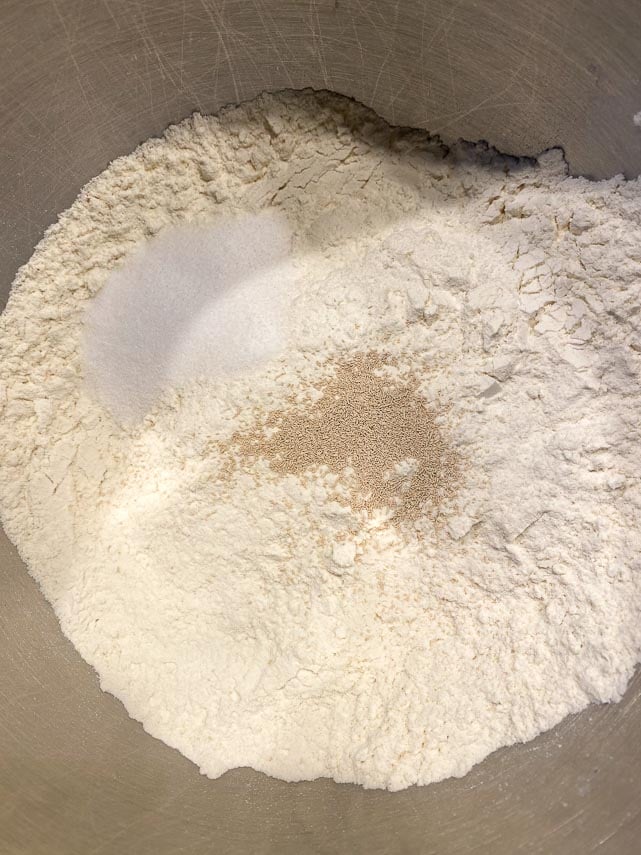
Add the warm water and olive oil and mix on low-medium speed until a wet dough forms, then turn speed up to medium to medium-high and beat until mixture looks like a soft, moist batter with a little elasticity.
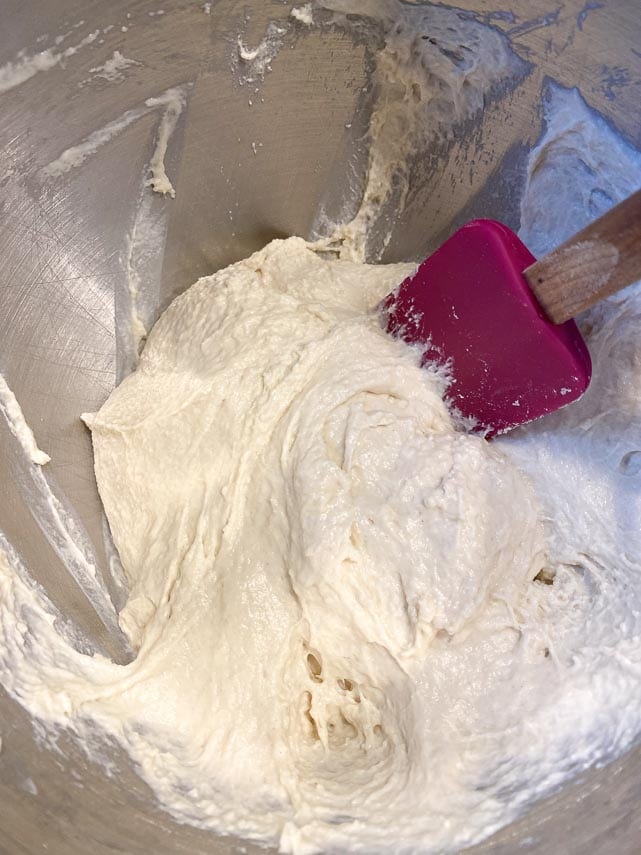
Lightly coat a bowl or container with olive oil, scrape the dough into the receptacle and turn the dough around to coat with oil. Seal the bowl with plastic wrap, or snap on a cover to the container.
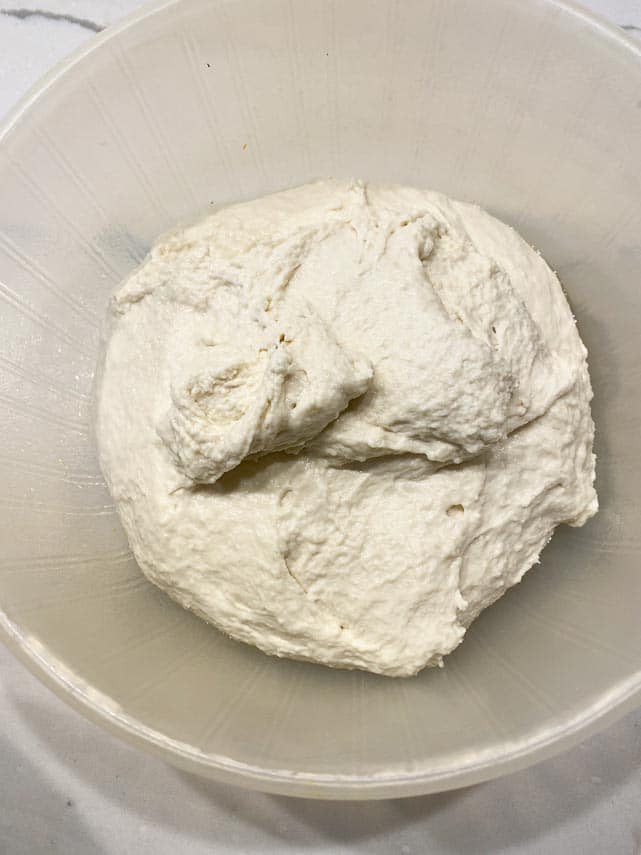
Place in refrigerator for 24 hours . Remove from fridge; it will look like this – sort of spongy.
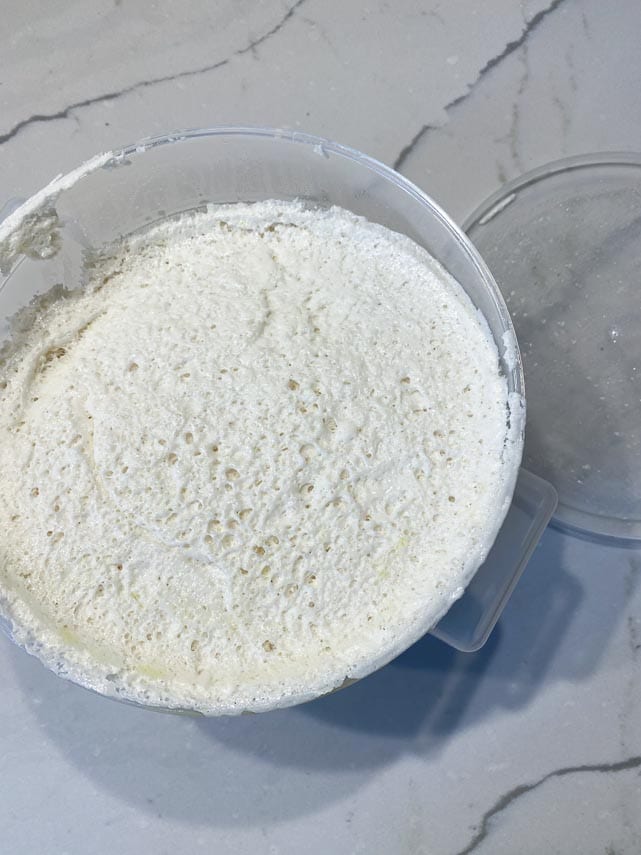
Cut two pieces of parchment paper that are about 14-inches (35.5 cm) around (round, square, rectangle – doesn’t really matter); set aside
Turn dough out onto a floured surface and use a bench scraper to divide the dough in half. Knead well, flouring all sides of your dough ball as you go, until you have a smooth elastic ball. This dough is very white and doesn’t look like any of our other doughs.
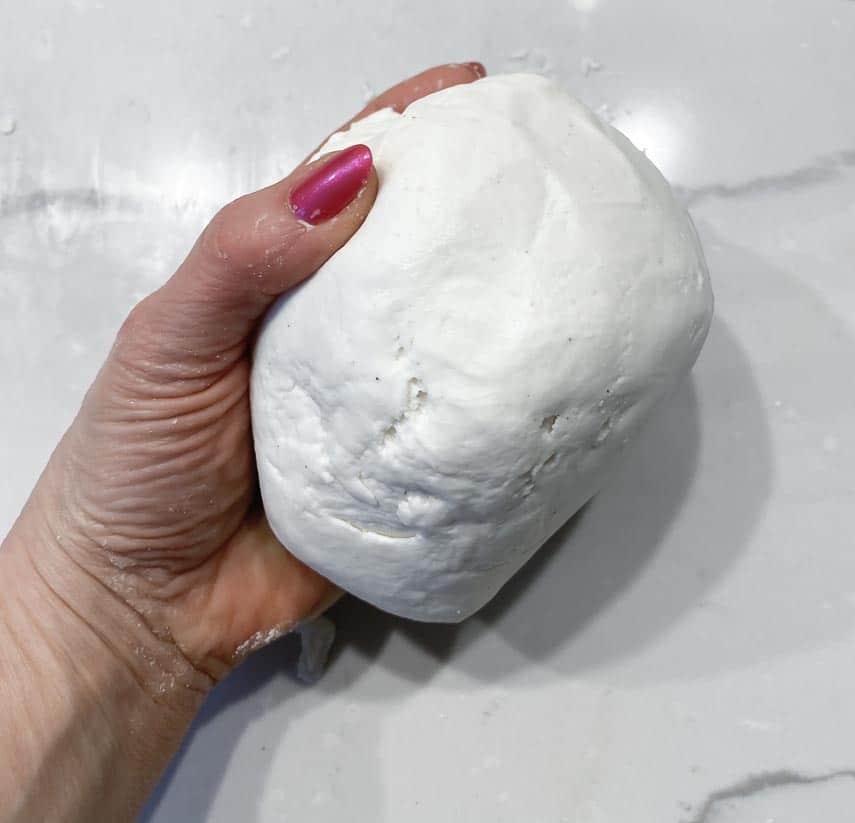
The saying goes that the balls should be as smooth and soft as a baby’s bottom and it is a helpful description. Cover with a cloth or plastic wrap and allow to sit for at least 3 hours to relax and come to room temperature.
Meanwhile, prep your sauce and toppings, which should be room temperature, or at least not cold.
Position rack in the hottest area of your oven. Place baking steel on rack. Preheat oven to 450°F (230°C) and allow baking steel to preheat for 1 full hour. Seriously, 1 hour.
One at a time, press your dough balls out on floured parchment rounds into discs about 12-inches (30.5 cm) around.
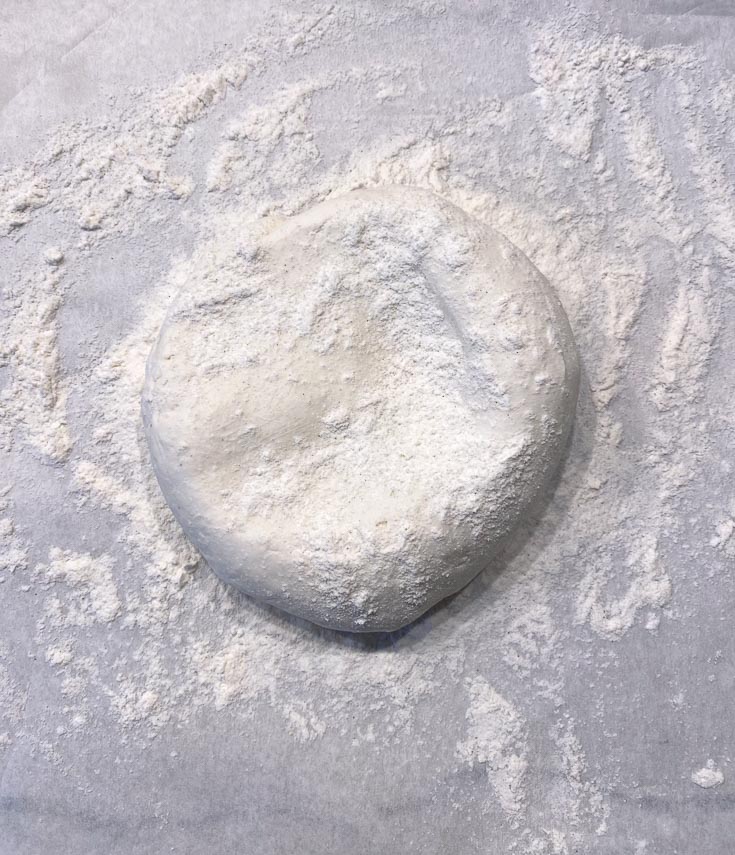
You can use your hands…
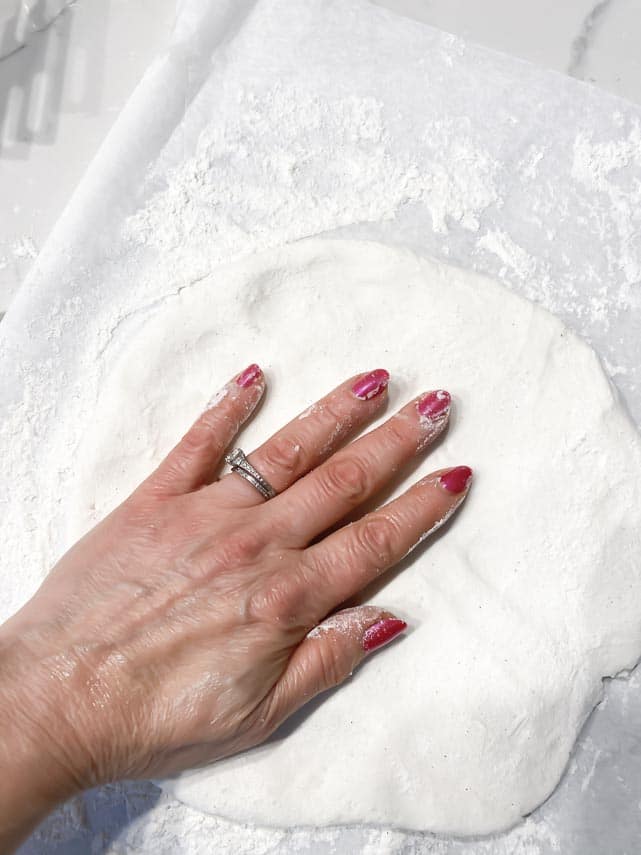
Or you can also use a small, hand-held rolling pin, if you like. Keep everything lightly floured to prevent sticking.
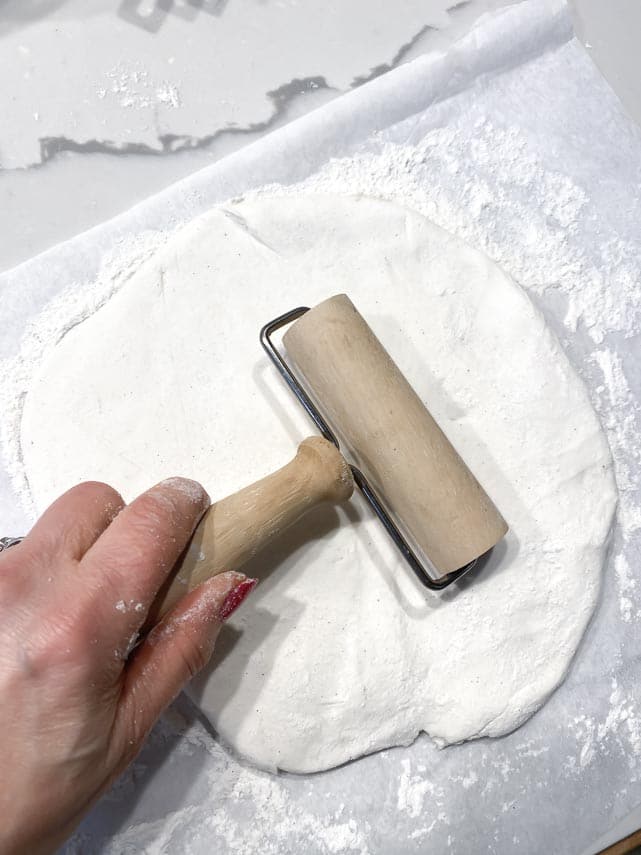
Slip your peel under the parchment holding a dough disc and brush it with olive oil.
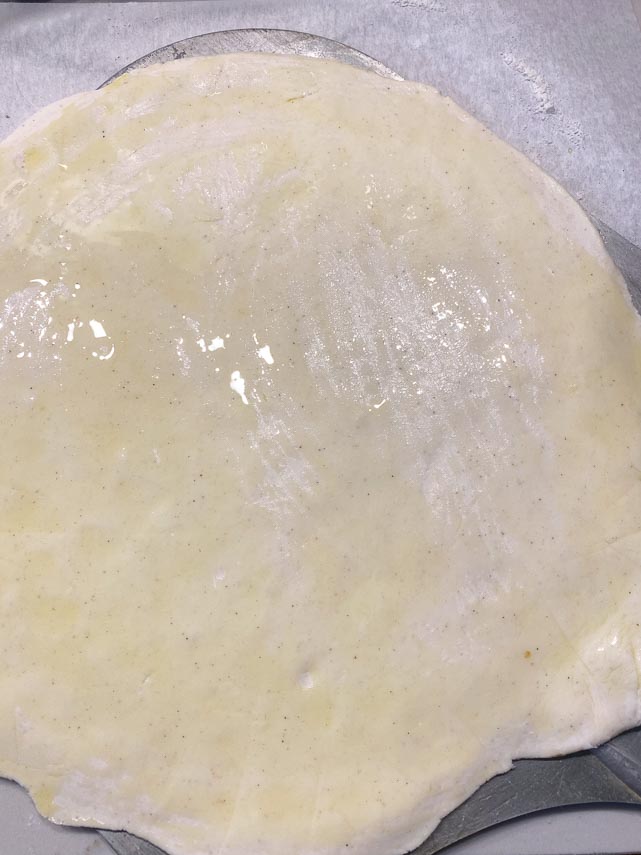
Launch into oven with the parchment in direct contact with the baking steel. Bake for about 3 to 4 minutes , or until just beginning to firm up and color, then quickly “strip” the parchment from under the pizza. Just pull it out and away. The pizza might look a bit bubbly, like this; remove the crust from the oven. Close the oven door to retain heat.
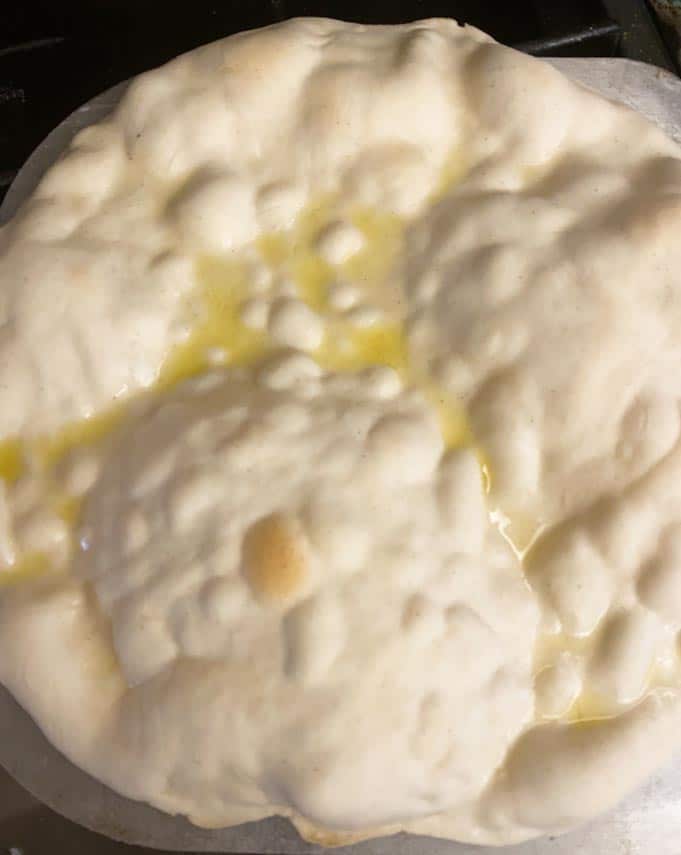
Get your toppings on the crust quickly, then get the pizza back into the oven. The pizza is now without parchment and in direct contact with the hot baking steel.
Continue to bake about 5 minutes more or until cheese is melted and bubbly (or toppings are “done”) and crust has some nice char marks. Look here below. It is NOT DONE YET:
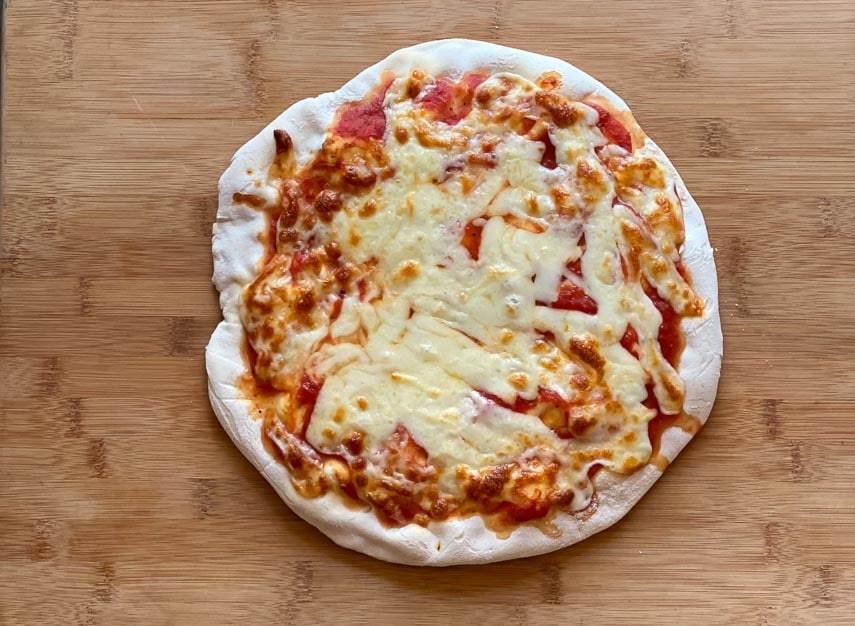
You want to cook this pizza until it gets some color; do not pull it out too early. It should look like this:

Serve immediately. Repeat with remaining dough ball.
Look at the crusty, crispy bottom!
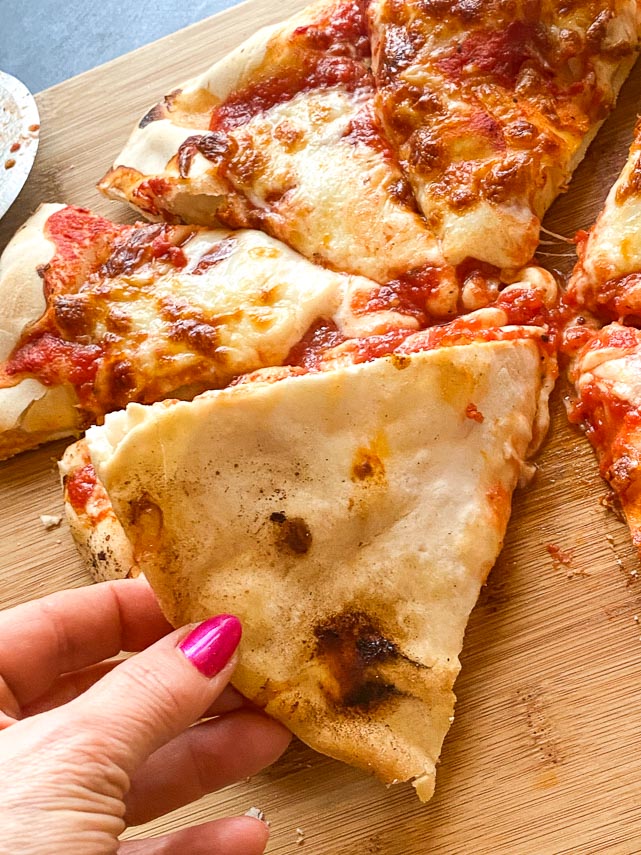
My #1 Tip For Making This Pizza
Do not underbake. Make sure you get some color on the crust. Err on the side of getting it a little too baked rather than pulling it out early.
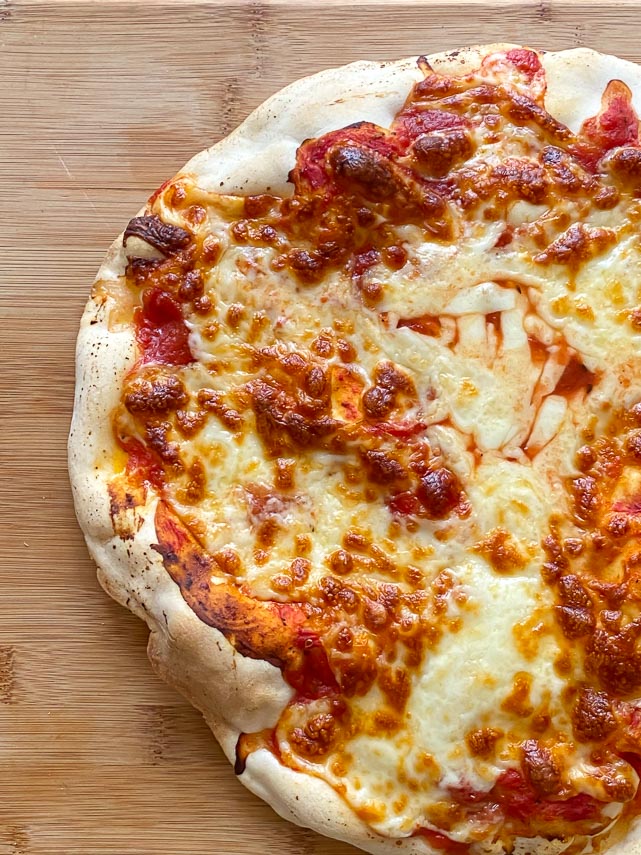
Here is a closeup of the crust, cut open:
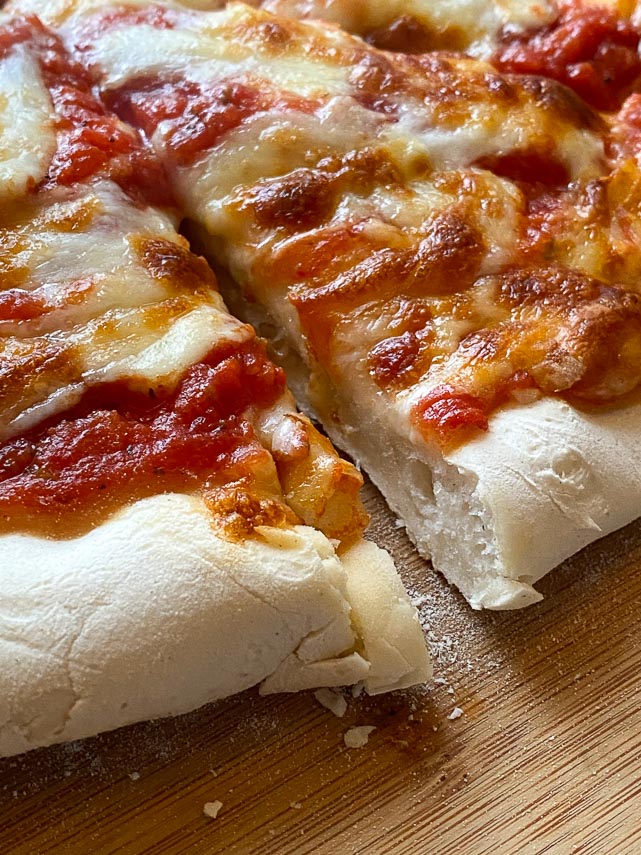
- Low FODMAP Easy Pizza
- Low FODMAP Pizza 2.0
- Low FODMAP Grilled Pizza
- Low FODMAP Deep-Dish Pizza
- And this one, our Caputo Fioreglut recipe
FODMAP Information
Our recipes are based on Monash University and FODMAP Friendly science.
- Canned Tomatoes: Monash University has lab tested canned tomatoes and they are low FODMAP at 92 g or 3.2-ounces, which they say is about ⅗ of a cup. Moderate FODMAPs kick in at about ¾ cup or 115 g, at which point fructose can become an issue.
- Cheese: Many cheeses have low FODMAP serving sizes. The low FODMAP diet is not a dairy-free diet. Hard cheeses such as Parmigiano Reggiano or Pecorino Romano have been lab tested by Monash University and are low FODMAP in 40 g amounts.
- Oil: All pure oils are fats and contain no carbohydrates, therefore they contain no FODMAPs.
- Sugar: Monash University and FODMAP Friendly have both lab tested white, granulated sugar. Monash states that a Green Light low FODMAP serving size of white sugar is ¼ cup (50 g). FODMAP Friendly simply states that they have tested 1 tablespoon and that it is low FODMAP. Regular granulated white sugar is sucrose, which is a disaccharide made up of equal parts glucoseand fructose. Sucrose is broken down and absorbed efficiently in the small intestine.
- Tomatoes: Both Monash University and FODMAP Friendly have lab tested common, beefsteak tomatoes. Monash University lab tests have shown no FODMAPs. FODMAP Friendly gives them a “Pass” at ½ cup (75 g) portions. Cherry tomatoes and Plum (Roma) tomatoes have also been tested by Monash and FODMAP Friendly. Both Monash and FODMAP Friendly recommend 75 g of cherry tomatoes as a serving (about 5 or ½ cup) and 75 g of plum or Roma tomatoes, which is about 1 small tomato or ½ cup.
- Yeast: Yeast – fresh, dry and instant – are all low FODMAP.
Please always refer to the Monash University & FODMAP Friendly smartphone apps for the most up-to-date lab tested information. As always, your tolerance is what counts; please eat accordingly. The ultimate goal of the low FODMAP diet is to eat as broadly as possible, without triggering symptoms, for the healthiest microbiome.
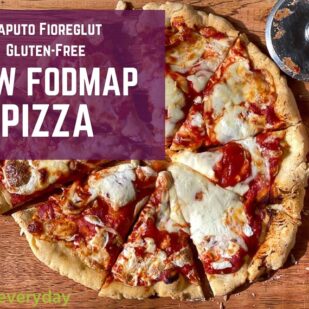
Caputo Fioreglut Gluten-Free Low FODMAP Pizza
This Caputo Fioreglut Gluten-Free Low FODMAP Pizza is just one of many gluten-free pizza recipes that we have for you. This one features Caputo Fioreglut Gluten-Free Flour, which contains an interesting ingredient: gluten-free wheat starch. Gluten-free wheat starch is made by washing away the gluten, resulting in a very dry powdery starch. Fructans in wheat, being water soluble, are also removed and/or reduced. If you are in Elimination and treading conservatively, this might not be the recipe for you, but we have others. Try our Easy Low FODMAP Pizza, for instance. Know your own tolerances.
Low FODMAP Serving Size Info: Makes 2, approximately 11-inch (28 cm) pizzas; 4 servings
Ingredients:
Pizza Dough:
- 500 grams (about 4 cups plus 2 generous tablespoons) Caputo Fioreglut Gluten-free Flour, plus extra
- 2 teaspoons instant yeast
- 1 ½ teaspoons salt
- 1 teaspoon sugar
- 1 ¾ cups (420 ml) warm water, 120°F to 125°F (48°C to 52°C)
- 2 tablespoons extra-virgin olive oil, plus extra
Sauce & Toppings:
- 1 ½ cups (360 ml) Low FODMAP Pizza Sauce or low FODMAP marinara
- 12- ounces (340 g) shredded or thinly sliced low-moisture mozzarella
- Low FODMAP pepperoni
- Sautéed red or green peppers or oyster mushrooms
- Other low FODMAP toppings
- Fresh basil leaves; optional – to be added after baking
Preparation:
-
For Making By Hand: Whisk together the 500 g of flour, yeast, salt and sugar in a large bowl to aerate and combine. Add the warm water and 2 tablespoons olive oil and begin to stir together with a sturdy wooden spoon until a wet dough forms, then beat vigorously until mixture looks like a soft, moist batter with a little elasticity.
-
For Making With A Stand Mixer: Place the 500 g of flour, yeast, salt and sugar in stand mixer bowl fitted with flat paddle or dough hook attachment and mix on low to aerate and combine. Add the warm water and 2 tablespoons olive oil and mix on low-medium speed until a wet dough forms, then turn speed up to medium to medium-high and beat until mixture looks like a soft, moist batter with a little elasticity.
-
Lightly coat a bowl or container with olive oil, scrape the dough into the receptacle and turn the dough around to coat with oil. Seal the bowl with plastic wrap, or snap on a cover to the container. Place in refrigerator for 24 hours.
-
Cut two pieces of parchment paper that are about 14-inches (35.5 cm) around; set aside
-
Remove from refrigerator, turn out onto a floured surface and use a bench scraper to divide the dough in half. Knead well, flouring all sides of your dough ball as you go, until you have a smooth elastic ball. The saying goes that the balls should be as smooth and soft as a baby’s bottom and it is a helpful description. Cover with a cloth or plastic wrap and allow to sit for at least 3 hours to relax and come to room temperature.
-
Meanwhile, prep your sauce and toppings, which should be room temperature, or at least not cold.
-
Position rack in the hottest area of your oven. Place baking steel on rack. Preheat oven to 450°F (230°C) and allow baking steel to preheat for 1 full hour. Seriously, 1 hour.
-
One at a time, press your dough balls out on floured parchment rounds into discs about 12-inches (30.5 cm) around. You can also use a rolling pin, if you like. Keep everything lightly floured to prevent sticking. Slip your peel under a parchment round holding a dough disc and brush it with olive oil.
-
Launch into oven with the parchment in direct contact with the baking steel. Bake for about 3 to 4 minutes , or until just beginning to firm up and color. Open the oven and quickly remove the pizza and parchment with a peel. Close the oven door to retain heat. Quickly and carefully grab the free edge of the parchment and pull it away from under the pizza. If the dough sticks, it isn’t parbaked long enough. Once you strip the parchment away it is time to apply your sauce and toppings swiftly. Get your pizza back into the oven where it will now be in direct contact with the preheated steel and will develop great color and texture.
-
Continue to bake about 5 minutes more or until cheese is melted and bubbly (or toppings are “done”) and crust has some nice char marks. You want to cook this pizza until it gets some color; do not pull it out too early. Serve immediately. Repeat with remaining dough ball.
Notes:
FODMAP Information
Our recipes are based on Monash University and FODMAP Friendly science.
- Canned Tomatoes: Monash University has lab tested canned tomatoes and they are low FODMAP at 92 g or 3.2-ounces, which they say is about ⅗ of a cup. Moderate FODMAPs kick in at about ¾ cup or 115 g, at which point fructose can become an issue.
- Cheese: Many cheeses have low FODMAP serving sizes. The low FODMAP diet is not a dairy-free diet. Hard cheeses such as Parmigiano Reggiano or Pecorino Romano have been lab tested by Monash University and are low FODMAP in 40 g amounts.
- Oil: All pure oils are fats and contain no carbohydrates, therefore they contain no FODMAPs.
- Sugar: Monash University and FODMAP Friendly have both lab tested white, granulated sugar. Monash states that a Green Light low FODMAP serving size of white sugar is ¼ cup (50 g). FODMAP Friendly simply states that they have tested 1 tablespoon and that it is low FODMAP. Regular granulated white sugar is sucrose, which is a disaccharide made up of equal parts glucose and fructose. Sucrose is broken down and absorbed efficiently in the small intestine.
- Tomatoes: Both Monash University and FODMAP Friendly have lab tested common, beefsteak tomatoes. Monash University lab tests have shown no FODMAPs. FODMAP Friendly gives them a “Pass” at ½ cup (75 g) portions. Cherry tomatoes and Plum (Roma) tomatoes have also been tested by Monash and FODMAP Friendly. Both Monash and FODMAP Friendly recommend 75 g of cherry tomatoes as a serving (about 5 or ½ cup) and 75 g of plum or Roma tomatoes, which is about 1 small tomato or ½ cup.
- Yeast: Yeast – fresh, dry and instant – are all low FODMAP.
Please always refer to the Monash University & FODMAP Friendly smartphone apps for the most up-to-date lab tested information. As always, your tolerance is what counts; please eat accordingly. The ultimate goal of the low FODMAP diet is to eat as broadly as possible, without triggering symptoms, for the healthiest microbiome.
Nutrition
All nutritional information is based on third-party calculations and should be considered estimates. Actual nutritional content will vary with brands used, measuring methods, portion sizes and more. For a more detailed explanation, please read our article Understanding The Nutrition Panel Within Our Recipes.
